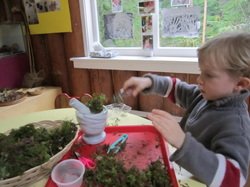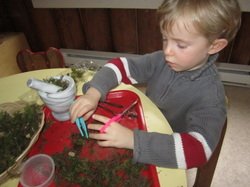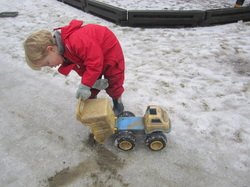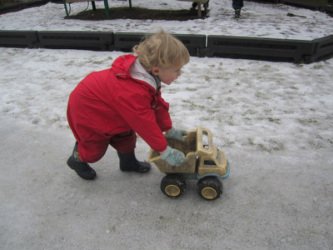PLAY IS SERIOUS BUSINESS: IT IS A CHILD'S WORK
January 28, 2014
James explored an invitation to transform some moss that we had collected in the forest. He uses scissors to cut the material and as he does this, he imagines: “My scissors are a chainsaw – they are cutting down a family of trees.”
The teacher inquires, “What are you going to use the wood for?”
James responds, “Scrap, it’s all scrap. This chainsaw sounds quiet--it’s a quiet chainsaw, snip, snip, snip.” James goes on ‘snipping’ the moss before continuing: “This chainsaw is getting worser—there’s bushes on the road--the sides and now cars can’t drive so I’m cutting the branches so the cars can go through.”
The teacher comments, “I’m glad you are doing that. It is important work!”
In this scenario James is processing what he had been observing in our environment, as road maintenance crews worked to clear the sides of our roadways from the overgrown brush.
Tuesday, February 11, 2014
“Wee… wee… wee,” goes James as he sped up and down the sidewalk pushing a toy truck. After several passes, the snow transforms into a dense surface.
James is having a great time going up and down the path but then something new occurs in his play as he left the truck on the sidewalk and ran to the sandbox to retrieve a handful of sand. He returns to the truck with the sand and drops it into the truck’s bucket.
James again pushes the truck up to the gate but this time on the way down, he dumps the sand directly in the middle of the sidewalk. His play takes on a definite orderly sequence: first, load up with sand, drive up, turn around, drive down and finally, dump the sand on the sidewalk. On James’ fourth trip from the sandbox, he becomes distracted by the teacher taking pictures, maybe sensing their curiosity or thinking about his awareness that ‘sand stays in the sandbox.’ But James offers us a window into his world by expressing, “The road is really icy. The truck is getting sand on the road. It’s really noisy to tell people it’s coming.”
Later on, James’ Mom shared with us that a few months back she and James had stood at the edge of the road and watched a truck sanding the slick surface. “James still talks about it,” Tanya noted.
Teacher’s Reflections:
Today as adults, if we want to find out about something, we “Google” it. We do this for just about anything, but what do preschoolers do? What is their “search engine?” How do they process all the new information and experiences they encounter? How do they manage to sort through it all?
How is James grasping the world of big powerful machines that chew up branches or spit out sand? How does he tame his ravenous curiosity?
The same that all his friends do: THROUGH PLAY!
Connecting Play with Literacy
“There are consistent findings in research about the close relationship between symbolic play and literacy development and good evidence that increasing opportunities for rich symbolic play can have a positive influence on literacy development,” Jane Hewes, PhD, Let the children play: nature’s answer to early learning (p4).
“Play is the answer to the question, how does anything new come about?” Jean Piaget.





